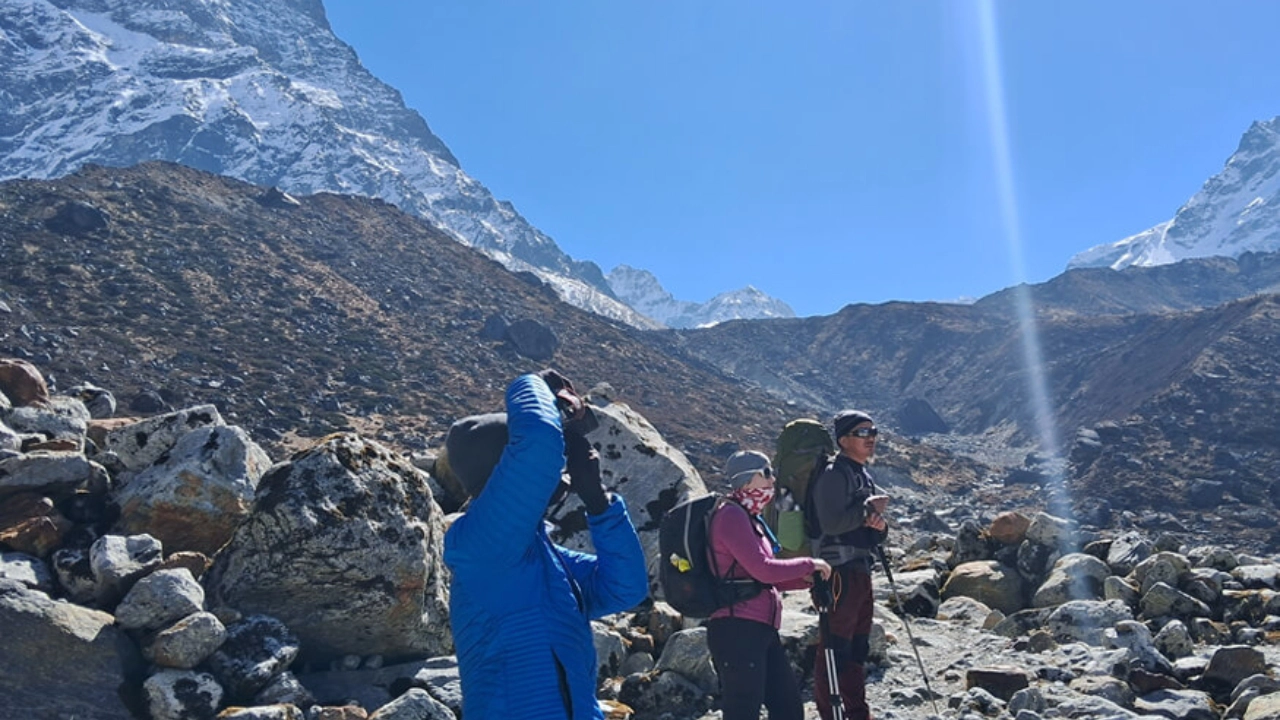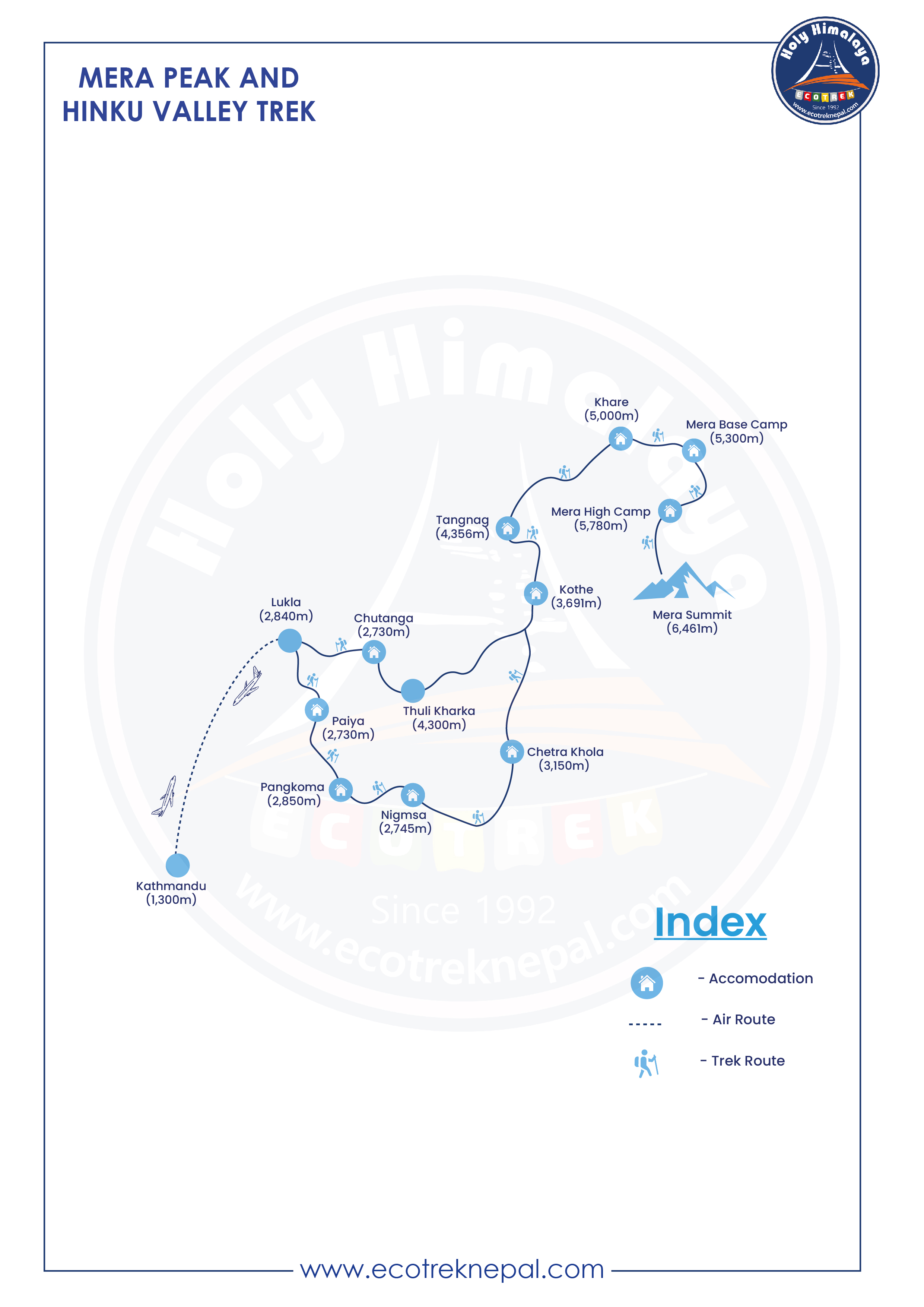
Mera Peak and Hindu Valley Trek
Tour snapshot
20 Days
2 persons
Nepal
Peak Expedition
Overview
Mera Peak is situated within the Himalayas and is a major center of activity for many trekkers who seek an ultimate challenge. It stands proud, reaching an elevation of 6,470 meters to cast its shadow on this wild landscape, commanding the watershed between the remote valleys of Hongu Drangkas. This is a majestic peak that, although lying south of Everest, cuts its own path, luring climbers into the enchanting realm of the Hinku Valley.
A voyage to Mera Peak and across the Hinku Valley is an amazing journey, rich in various feelings of adventure and calmness. While moving in the landscape, you'll go deep into the world of natural wonders, from green forests of rhododendrons up to wide-open alpine meadows seen as far as your eyes can grasp. The trek offers breathtaking scenery together with the opportunity to experience the culture of the Sherpa settlements found dotting the valleys.
Exhausting, but it is worth looking at unbelievable views. In case it is visible, one can simply behold a breathtaking view from some of the highest peaks in the world: the mighty Mt. Everest, Lhotse, and Makalu, amongst others. Each step to the top had said it all about an indomitable spirit for exploration, eventually driving him to new heights.
A walk over this mountain is a great invitation, which over and above the thrill contains a very rare and supreme chance for adventure, afforded by Mera and the Hinku Valley trek, far away from the hustle and bustle of modern civilization deep into the tranquility of Himalayan wilderness. On the trail, relief comes in the form of teahouses from time to time, and locals also give insight into the traditional culture of the people inhabiting this area and stop by ancient monasteries.
The Mera Peak and Hinku Valley Trek are more than a challenge of physical magnitude; rather, it invites one on a journey that will push one's limits with regard to what one perceives themselves to be capable of, with deep connections toward the timeless beauty of the Himalayas. So, pack your bags, lace up your boots, and go on an adventure of a lifetime into the heart of Nepal's most iconic landscapes.
Highlights
- Conquer Mera Peak, standing tall at 6,470 meters in the Himalayas.
- Trek through the stunning Hinku Valley with rhododendron forests and alpine meadows.
- Immerse yourself in Sherpa culture amidst traditional settlements.
- Summit Mera Peak for breathtaking views of the highest peaks.
- Experience ice-climbing and crossing snow-covered crevasses.
- Enjoy serene moments at teahouses and ancient monasteries.
- Witness stunning sunrises and sunsets at High Camp.
Itinerary




















Included/Excluded
Service Fee Only, Explore Nepal Fully!
Select Dates
{{type.name}}
{{type.display_price}} per person
Guests
Extra prices:
- {{total_price_html}}
- {{pay_now_price_html}}
FAQs about Mera Peak and Hindu Valley Trek

The best time to trek or climb Mera Peak is during the spring (March to May) and autumn (September to November) seasons. These periods offer the most favorable weather conditions, with clear skies and stable temperatures, which enhance visibility and safety. In spring, the blossoming flora adds a vibrant touch to the trek, while autumn provides crisp, clear views of the surrounding Himalayan peaks. These seasons also have less rainfall and snowfall compared to summer and winter, making the trails more accessible and enjoyable for climbers. Thus, planning your Mera Peak adventure in these months ensures an optimal experience.

Mera Peak is 6476 meters (21,247 feet) high. It is a good mountain for beginner climbers to try because it is not too difficult. You do not need special climbing skills or equipment like ropes, gear, or ice axes. Many people with little or no mountain climbing experience try to climb Mera Peak because the path up is fairly straightforward. However, you still need to prepare your body before attempting to climb Mera Peak. You should exercise and train for 4-6 months before your trip. This will help build up your strength and endurance. During the climb, you will need to carry a backpack weighing 5-8 kg (11–18 pounds) and walk uphill and downhill for 15–16 days. The final push to the summit will be very physically demanding. So while Mera Peak is suitable for beginners, you still need to get your body ready through aerobic exercises like running or cycling, as well as strength training. This will help prepare you for the challenging climb.

Mera Peak is rated as a 1B alpine-grade climb. This means it is considered a bit challenging but still suitable for beginners. For any mountain climb, the fitter and stronger you are, the better your chances of reaching the summit and enjoying the whole experience. Your ability to summit Mera Peak mostly depends on the weather conditions on that day and how physically prepared you are. The final climb to the summit usually starts around 3 or 4 a.m. It takes about 3–4 hours of climbing to reach the top. While the climbing route itself is not too technically difficult, the main challenge is getting used to the high altitude. Proper acclimatization to the thin air at high elevations is very important. So while Mera Peak's climb is straightforward from a technical perspective, being physically fit and allowing your body to adjust to the high altitude are crucial for summiting successfully.

Mera Peak is 6,476 meters (21,247 feet) high and a very popular trekking peak in Nepal. To climb Mera Peak, you need to get certain permits and follow rules set by the Nepalese government. Climbing Permit You must obtain a climbing permit from the Nepal Mountaineering Association (NMA). The cost of this permit changes depending on what time of year you climb. Makalu Barun National Park Entry Permit Since the trek to Mera Peak goes through Makalu Barun National Park, you also need an entry permit for this park. Once inside the national park, you will see many different types of plants and animals that are protected by the park management.

On the Mera Peak climb, nutritious and energy-dense meals are provided to fuel the strenuous trekking. At base camp, warm meals like dal bhat (lentils and rice), soups, and vegetables offer carbs, protein, and vitamins. Higher-up, lightweight snacks like trail mix, energy bars, and chocolates provide quick energy boosts. Staying hydrated is crucial, with natural water sources like streams and lakes available en route. Guides carry purification tablets to ensure safe drinking water. At high altitudes, frequent sipping and herbal teas help prevent dehydration despite the dry mountain air. Overall, proper fueling and hydration facilities support climbers throughout the challenging Mera Peak expedition.

The accommodation facilities on the Mera Peak climb range from basic tea houses to tented campsites. Along the trekking trail, tea houses run by local Sherpa families provide simple yet cozy lodging with dining halls and sleeping quarters equipped with thick blankets. Though amenities are modest, the hospitality offers a cultural experience. At base camp, sturdy tents with sleeping bags and insulated mats serve as accommodations before the summit push. Despite being removed from modern comforts, the climbers' camaraderie and stunning mountain views create a memorable experience. Overall, the accommodation caters to essential needs while immersing trekkers in the region's rugged beauty.











